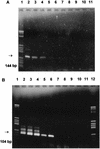Molecular approaches to diagnosis of pulmonary diseases due to Mycoplasma pneumoniae
- PMID: 9466774
- PMCID: PMC104575
- DOI: 10.1128/JCM.36.2.548-551.1998
Molecular approaches to diagnosis of pulmonary diseases due to Mycoplasma pneumoniae
Abstract
In this prospective study, the use of a culture-enhanced PCR assay for the detection of Mycoplasma pneumoniae, followed by hybridization with a specific probe (MP-HPCR) or without hybridization (MP-PCR), and the use of a nested PCR (MP-NPCR) were evaluated. Clinical samples (190 specimens) from 190 patients with respiratory complaints were incubated in culture broth overnight and then subjected to PCR. The results of the PCR were compared to those obtained by culture, the direct antigen test, and serologic testing by microparticle agglutination and by immunoblotting in unclear cases. The sensitivities were 19 CFU for MP-PCR, 1.9 CFU for MP-HPCR, and 0.019 CFU for MP-NPCR. PCR amplification of the beta-globin gene was possible in 98% of cases: after dilution of the beta-globin-negative samples, all samples were reactive. Correlation between negative MP-NPCR results and negative serology results was found in 89% of cases; a positive correlation was found with 10% of the patients. Samples from three immunocompromised patients were MP-NPCR positive but serologically negative. High respiratory colonization by M. pneumoniae (>10(5) CFU/ml) in patients with acute respiratory disease could be detected by culture, MP-PCR, and MP-NPCR. These results indicate that MP-PCR and MP-NPCR are reliable methods for the detection of M. pneumoniae in respiratory tract samples of patients with respiratory complaints.
Figures

References
-
- Abele-Horn M, Wolff C, Dressel P, Zimmermann A, Vahlensieck W, Pfaff F, Ruckdeschel G. Polymerase chain reaction versus culture for detection of Ureaplasma urealyticum and Mycoplasma hominis in the urogenital tract of adults and the respiratory tract of newborns. Eur J Clin Microbiol Infect Dis. 1996;15:595–598. - PubMed
-
- Blanchard A, Hentschel J, Duffy L, Baldus K. Detection of Ureaplasma urealyticum by polymerase chain reaction in the urogenital tract of adults, in amniotic fluid, and in the respiratory tract of newborns. Clin Infect Dis. 1993;17:S148–S153. - PubMed
-
- Clyde, W. A. 1993. Clinical overview of typical Mycoplasma pneumoniae infections. Clin. Infect. Dis. 17(Suppl. 1):S32–S37. - PubMed
Publication types
MeSH terms
Substances
LinkOut - more resources
Full Text Sources
Medical

